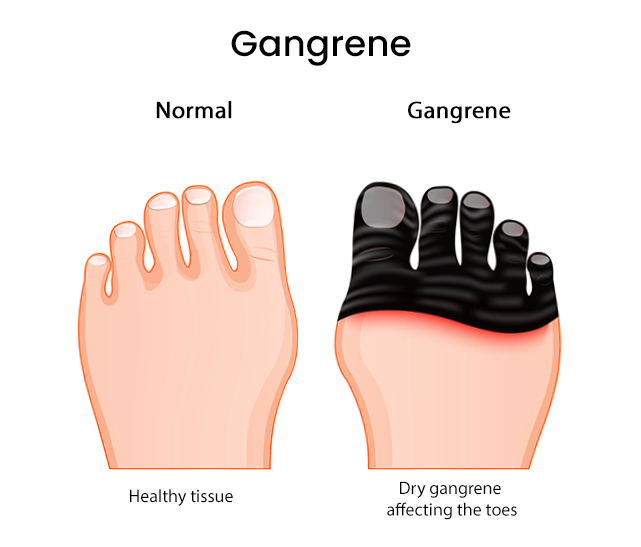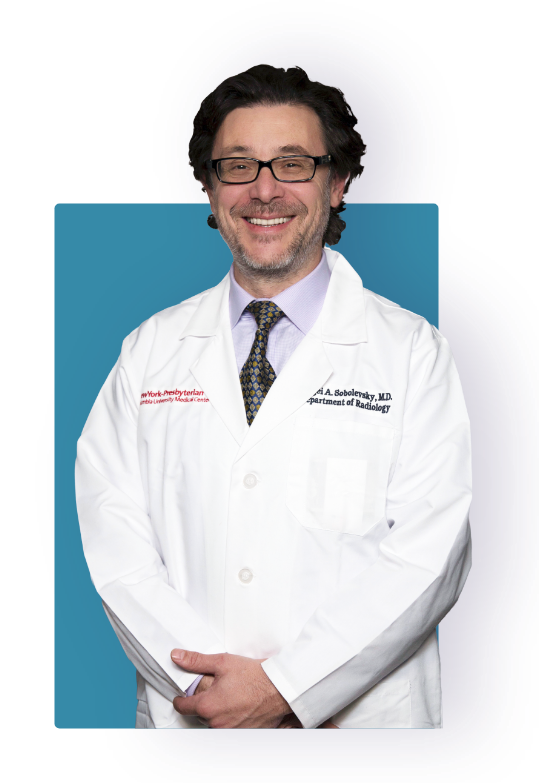Long ago, a gangrene was a serious and common condition. Today, there is almost no excuse for allowing a gangrene to happen, when an expert diagnosis and early treatment for gangrene is so close at hand in Brooklyn at the Downtown Vein & Vascular Center. If you have gangrenous toes, especially when you also have diabetes, call an experienced doctor to take care of you properly. It literally is a matter of life and death.
What Is Gangrene?
When you don’t treat a severe infection or lack of blood flow to a certain area, it can lead to the breakdown and death of tissue, which is known as gangrene. This condition most commonly causes gangrenous toes and feet, but also affects fingers, arms and legs. You also may require treatment for gangrene of internal organs or muscles. Two forms of gangrene include:
- Dry gangrene. This type of gangrene develops slowly and happens when blood supply is cut off from tissues. This causes the tissue to dry and fall off.
- Wet gangrene. If bacteria invade the tissue, you usually see swelling and fluid drainage, as well as a foul odor. The infection from wet gangrene can quickly spread throughout your body.
Any type of gangrene requires prompt medical care and signs of this condition should never be ignored. Your best choice for expert gangrene treatments and treatment for other vein and artery conditions in Brooklyn is the Downtown Vein & Vascular Center. A top vein expert diagnoses your circulation problems and recommends the best gangrene treatment when you need it.

What Are the Signs and Symptoms of Gangrene?
The symptoms that may lead to gangrene vary, depending on an underlying cause. Signs of the condition include:
- Numb or cold skin
- Redness or swelling
- Discoloration or color changes to blue, purple, brown or black
- Skin that feels tender to the touch
- Pain in or near the affected area
Wet gangrene may also be accompanied by signs of infection, such as:
- Persistent fever
- Pus or drainage from the affected area
- Blisters or sores with a bad smell
If the infection gets into your bloodstream, it can lead to septic shock, which includes such symptoms as rapid heartbeat, a fall in the blood pressure, shortness of breath and cold, clammy skin.
★ ★ ★ ★ ★
Excellent Care
Dr. Sobolevsky provided excellent care during my vein treatment. He was professional, knowledgeable, and made me feel comfortable throughout the procedure. I’m thrilled with the results and would highly recommend him to anyone seeking vein treatment.
What Causes Gangrene?
When there’s reduced blood flow to a part of your body, tissues begin to die. Gangrene is caused by reduced blood flow or a serious bacterial infection. It can also develop after tissues are injured:
- In combat
- From an animal bite
- Due to frostbite
- Because of a burn
Some chronic health conditions increase the risk of developing gangrene. Gangrene is often associated with chronic conditions, such as diabetes, autoimmune conditions, circulation problems, atherosclerosis or peripheral artery disease.
Pay attention to any wounds you might have, particularly if you’re diabetic or have peripheral vascular disease. Watch for redness, cuts, sores or swelling. If you’re diabetic, work on keeping your blood sugar under control. The risk of developing peripheral artery disease increases with age, and it’s important to consume a healthy diet, increase physical activity and control high blood pressure.
What Are Some Gangrene Treatment Options?
Gangrene treatments vary, depending on the cause. The goal is to remove dead tissue, improve blood flow and stop the spread of infection as soon as possible. For all types of gangrene, the sooner treatment is started, the better your chance of recovery. You may benefit from a combination of treatment approaches, including:
- When a bacterial infection has caused a gangrene to develop, antibiotics typically are prescribed to kill the infection.
- Maggot therapy. Maggots from fly larvae are placed on the wound where they eat dead tissue without harming healthy tissue.
- This is a surgical procedure done to remove tissue that’s infected and prevent further spread of infection.
- Revascularization. A procedure may be done to repair damaged blood vessels and restore blood flow.
- Oxygen therapy. Treatment in a hyperbaric chamber helps blood carry more oxygen, which then helps wounds heal more quickly.
- Reconstructive surgery. Skin grafting may be done to repair damaged skin.
- A gangrenous toe or a limb may require surgical removal, which is usually the last resort.
To determine the best plan for a gangrene treatment, your Brooklyn vein and artery specialist reviews your overall health, age and medical history. Tissues that have been severely damaged can’t be saved, but prompt treatment can stop it from spreading.
What Happens if I Don’t Get Gangrene Treatment?
Gangrene is a dangerous and potentially life-threatening condition. Get immediate medical attention if signs of this condition develop, such as skin that’s cold, hard, pale, numb or an unusual color. Untreated gangrene can lead to loss of a limb, organ failure or death.
Contact the expert at the Downtown Vein & Vascular Center in Brooklyn if you have signs of gangrene or pain in your legs, arms, toes or fingers that may be related to vein or artery disease. In addition to expertise in evaluation and treatment of a gangrene, Dr. Sergei Sobolevsky provides the most advanced vein treatments for conditions such as:

I am Dr. Sergei Sobolevsky, a leading specialist in endovascular medicine. Having performed over 25,000 procedures throughout my career, I bring decades of experience in vascular and interventional radiology to my practice. I obtained my Doctor of Medicine (MD) degree from the University of Colorado School of Medicine in 1997 and completed my specialty clinical training in vascular and interventional radiology at Harvard University.
My dedication to excellence in patient care has been recognized through accolades such as being named a Castle Connolly Top Doctor and inclusion in the Top Doctors New York Metro Area lists for 2020, 2021, 2022, and 2023. With licenses in multiple states, I have also shared my expertise through presentations at various institutions in the US and abroad.
More About Dr. SobolevskyDowntown Vein Treatment Center
480 Court Street, Ste 101
Brooklyn, NY 11231
(718) 787-5559


